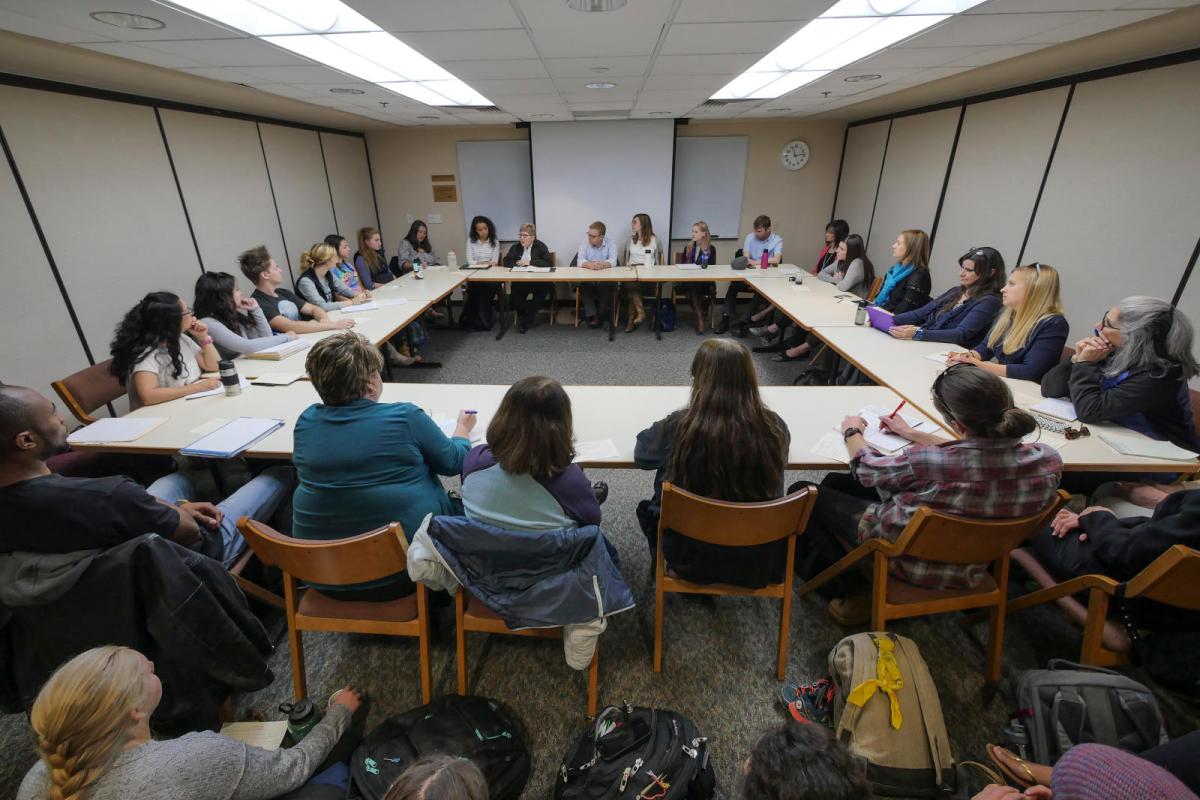Inclusive Hiring Process
Striving to Ensure Equitability and Inclusivity in Faculty Hiring
The Environmental Studies Program (ENVS) at the University of Colorado Boulder is dedicated to integrating the principles of inclusive excellence into its faculty-hiring process.
Below, you will find our Step-by-Step Guide to Inclusive Faculty Hiring. Whether or not you are serving on a hiring committee for ENVS, we hope you will find this resource useful.
ENVS is committed to redressing disparities in representation in academic professions. An important part of this project is acknowledging and working to dismantle systemic white supremacy. Please see our Statement on Condemning Racism.
Underrepresentation and Overrepresentation in Academic Communities
Inclusive faculty-hiring protocols are intended to address structural inequities resulting in the underrepresentation of certain social groups (read differently as the overrepresentation of certain social groups) in academic workplaces. Social categories considered here include but are not limited to:
- People who identify and/or are profiled as BIPOC
- People who are disabled and/or differently abled
- People who identify and/or are profiled as female
- People who identify and/or are profiled as LGBTQIA+
- People who are socioeconomically disadvantaged
- Members of socially marginalized and/or devout religious communities
- People whose physiological attributes (e.g., weight, height, pigmentation, voice, etc.) do not align with societal standards/ideals
- People who enter the job market at an older-than-typical age
- People whose first language is not English
- People whose nationality/citizenship status is subject to social stigmatization
For a list of social categories protected under CU Boulder's Discrimination and Harassment Policy, please see this link.
It is important to note that where each underrepresented social category is concerned, representation varies across the academy as well as within different departments/programs, colleges/universities, and academic disciplines/fields.
ENVS faculty-hiring bodies will comply with university policy and state and federal law.
Intersectionality
Members of underrepresented groups do not encounter discrimination in a uniform manner. Historical circumstances have, for example, resulted in different expressions of racism toward—and different experiences of racism by—members of different groups that have been racialized "non-white." People with certain manifestations of physical and/or neurological difference experience greater/less social acceptance than people with other manifestations of physical and/or neurological difference. An individual who enters the job market at the age of forty-five may encounter less age-related discrimination than someone who is a decade or two older. These are just a few examples of the myriad ways in which the effects of institutional inequity vary in relation to individual members of underrepresented groups.
Furthermore, underrepresented social categories are, of course, not mutually exclusive. People who are gendered female do not share a universal experience of gendered discrimination. In fact, gender biases often intersect with racism to produce compound expressions/experiences of discrimination. Likewise, people who identify as LGBTQIA+ may also be members of other underrepresented social categories. The same can be said for people who are differently-abled. Again, these are just a few examples of the many ways in which intersectionality shapes self-identification and social profiling.
In addition, socioeconomic status affects opportunity in powerful and complicated ways. The socioeconomic disadvantage is often a product of historical disparities in access to resources—disparities that disproportionately affect members of marginalized ethnic and/or racialized groups.
In other words, social identities are layered. In the lived experiences of individual applicants, adversity and privilege can intersect and overlap. To counteract systemic inequities that have resulted in the overrepresentation of privileged social groups in academic professions, effective hiring committees must remain cognizant of this complexity.
The Necessity of Implementing Institutional Safeguards to Increase Faculty Diversity
Enhancing equitability and inclusivity in faculty hiring is not simply a matter of meaning well. At every step in the hiring process, structural advantages/disadvantages and implicit biases threaten to undermine the efforts of even the most well-intentioned hiring committee. Overt discrimination can also come into play. It is therefore incumbent upon hiring authorities to adopt protocols at every stage of the hiring process to counter institutional barriers to inclusivity, equitability, and faculty diversification.
Our Commitment
The Environmental Studies Program at the University of Colorado Boulder has identified strategies that hiring committees can employ to address problems that arise throughout the hiring process. At the top of this page, in our Step-by-Step Guide to Inclusive Faculty Hiring, you will find protocols for each of the eight phases in the program's faculty-hiring life cycle. Please explore this content to better understand how discrimination and structural inequity affect faculty hiring and what the Environmental Studies Program is doing to combat the widespread overrepresentation of privileged perspectives and underrepresentation of socially marginalized groups in academic professions.
General Resources
Throughout our Step-by-Step Guide to Inclusive Faculty Hiring, you will find external resources that address specific aspects of the inclusive and equitable faculty-hiring process, but here are other resources you may find more broadly useful:
- Must-Read Articles on Faculty Diversification
- CU Boulder's Office of Diversity, Equity and Community Engagement
- National Center for Faculty Development & Diversity
- CU Boulder's Human Resources: Diversity and Inclusive Excellence
- CU Boulder's Faculty Search Process Manual (in its entirety)
- CU Boulder's Faculty Search and Hiring Online Course (accessible to all)
- Webinar on Faculty Diversification (produced by Urban Universities for HEALTH)
- Data on Diversity at CU Boulder









